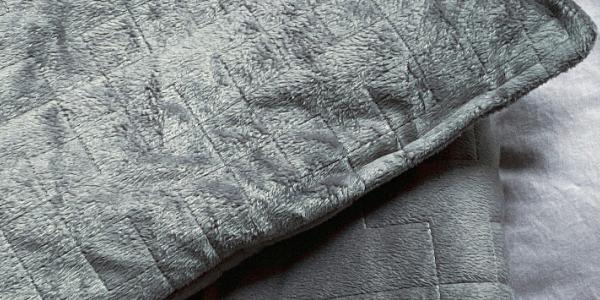
Weighted blankets have become increasingly popular in recent years, but how do they help — and do they actually work?
You’ve likely already heard a friend or co-worker rave about the benefits of weighted blankets. Research suggests that weighted blankets can help improve sleep and ease symptoms of anxiety, such as racing heartbeat, heavy breathing and nervousness. Studies claim that weighted blankets even help people with conditions like anxiety, depression, autism and ADHD. With so many intriguing claims and a nation that’s more anxious and sleep-deprived than ever, is it worth giving a weighted blanket a try? Let’s take a closer look.
There are a lot of claims about the effectiveness of weighted blankets, but what does the research say?
- Claim: Weighted blankets can help you sleep better.
Some research suggests that weighted blankets can help people with insomnia get better quality sleep. However, weighted blankets alone aren’t necessarily a cure for insomnia, so make sure to talk with your doctor if your sleep troubles persist — you could have a more serious sleep disorder, such as sleep apnea, that requires additional treatment.
- Claim: Weighted blankets can help your nervous system.
Research suggests that the pressure of a weighted blanket mirrors the soothing nature of a hug or swaddle. This pressure can trigger a response from your nervous system that lowers elevated heart rate and regulates breathing.
- Claim: Weighted blankets help individuals with autism.
Weighted blankets have been used for years to help aid children and adults with autism. Research indicates that weighted blankets serve as a sensory tool, calming nerves and anxieties during moments of distress. While these benefits can be soothing for anyone using a weighted blanket, many individuals with autism find them especially comforting.
Skip
Choosing the right weighted blanket
With so many different kinds of weighted blankets, it can be difficult to know which is best. There are four main factors you should consider when choosing your blanket: weight, temperature, size and filling.
- Weight: Select a blanket that weighs roughly 10% of your body weight. Most blankets start at ten pounds and go up to 25. If you are between two weight options, consider going up a weight. For children, there are lighter blanket options available.
- Temperature: If you’re worried about getting too hot with a weighted blanket, look for a blanket with breathable fabric, such as cotton or bamboo. While you may think a lighter blanket will be less warm, the key factor in temperature is actually the external material of the blanket, rather than the weight itself.
- Size: Most weighted blankets are about the size of a twin blanket, which is the recommended size for adults. However, you can also find blankets in larger sizes, if you prefer. Weighted blankets should cover the body from the neck down without much leftover.
- Filling: The majority of weighted blankets are either filled with glass beads or plastic pellets. Glass beads tend to be smaller and take up less space than plastic pellets, so the blanket will be thinner and less bulky. There’s no conclusive evidence on which filling is better, so it’s up to personal preference.
Our top picks
We've taken a look at some of the best weighted blankets out there. Here a few options that you might consider:
- Top rated: This unique weighted blanket is made from layers of cotton rather than glass beads or plastic pellets. With over a thousand positive reviews, this “Cotton Napper” comes in at $249 and has three weight options: 15, 20 and 25 lbs. Sold online through West Elm and Bearaby.
- Most affordable: With over 36,000 reviews, the YnM weighted blanket comes highly recommended while remaining more affordable at $65 on Amazon.
- Sustainable: If you're looking for the most environmentally-friendly blanket possible, consider this 100% velvet blanket sold online through Saatva for $295. It comes in two weights, 15 and 25 lbs, with glass beads.
The bottom line
Weighted blankets are a safe and easy way to improve your sleep quality by relieving anxiety symptoms. If you’re looking for a new sleep aid, a weighted blanket may be just what you need!
This article first appeared in the March 2021 edition of the HealthPerks newsletter.

